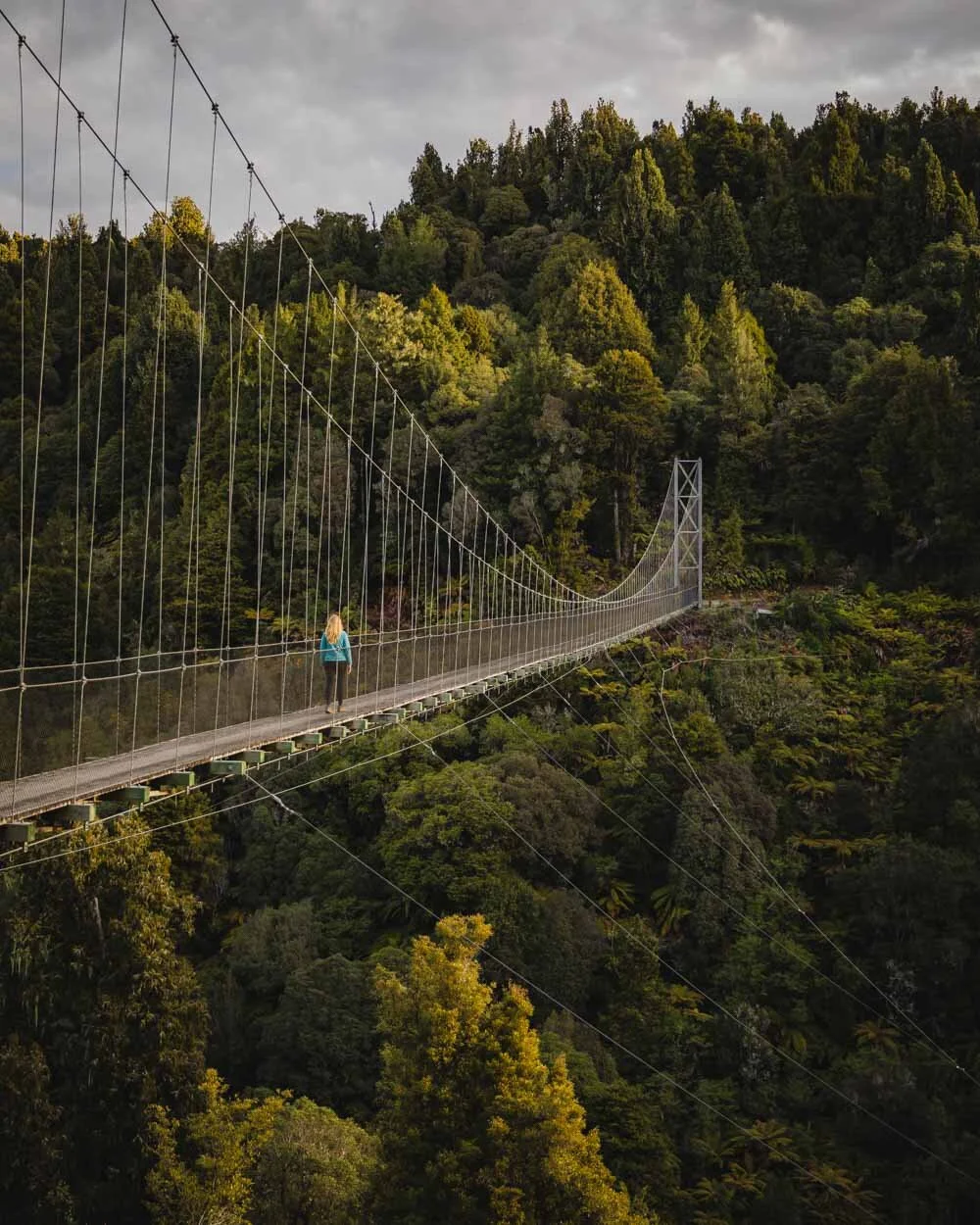It’s high, it’s long and there’s just enough of a wobble to make it feel exciting. It’s only when you walk part of the way along that you’ll also get to truly appreciate what a stunning setting it’s in, with giant ferns and greenery so dense that despite the area’s history it feels wild and untouched.
The Maramataha Bridge is one of the longest and highest suspension bridges in New Zealand, and can be visited on foot or by bicycle.
Here’s everything you need to know about accessing Maramataha Bridge, the Timber Trail’s best.
The Maramataha Bridge
The quick route to the bridge
Distance: 5km return
Elevation: 130m
Difficulty: Easy
As mentioned, you can either walk or cycle the trail, we chose to walk. The path is well maintained and is generally gravel or hard compact dirt. It held up really well mud-wise against the onslaught of rain we’d had, so it’s a good track for any weather.
The trail undulates gently much of the way but is never steep, everything feels very gradual.
As for the scenery the first half of the track is in spectacular forest, with huge numbers of giant trees ferns and plenty of branches which are dripping in moss.
It’s a really lovely forest, full of birdlife and wonderfully peaceful. We didn’t encounter anyone else on the walk either, which only added to the serenity.
The forest does open up sadly and whilst the trail is still pleasant, you no longer feel like you’re in the forest as such, but more passing in-between it.
The track is really well signposted and it only takes around 25 minutes to reach the bridge.
Just watch out when you’re ready to leave the bridge that you look out for the Timber Trail sign again; we weren’t paying attention and ended up walking for nearly a kilometre uphill along a totally different track!
The bridge experience
The Maramataha Bridge is a whopping 141m long and 53m high, not just the longest and highest on the Timber Trail, but one of the longest in the country - I think it’s the third longest but don’t quote me on it!
It feels even longer when you walk over it than you imagine it would when you first see it.
It’s an amazing feat of engineering and a lot of fun to walk or ride over. As it was built with cyclists in mind, it’s wider than other suspension bridges we’ve visited in New Zealand - if you love the narrow kind that really sway then head to the Roberts Point Track in Franz Josef.
As you walk across the bridge you can look out to the incredible forest. Although the area was extensively logged it still contains one of the last remaining intact podocarp forests in the world.
You can also look down into the river and the series of cascades which is known whio (blue duck) habitat - whio are one of the rarest birds in New Zealand and even grace the $10 bank note.
We didn’t spot any but we do seem to repel them as we’ve looked so many times in different areas and not yet got lucky!
Walking across the bridge is a lot of fun and I imagine it would go down a storm with kids too!
If walking over Maramataha Bridge has you keen for more, then there are seven other suspension bridges located along the Timber Trail!
If you’re looking for other fab things to do in the area, we have a full guide to the Waitomo region here.
How to get there
The Maramataha Bridge is located between Waitomo and Taumaranui in the Pureora Forest off SH30.
It’s almost exactly halfway along the 85km Timber Trail, which is most popularly completed by bike, but it can also be done on foot. However, those looking for a short adventure to the bridge alone don’t have to start at the beginning of the Timber Trail, there’s actually a car park just 2.8km from the bridge itself.
We didn’t find any information about it online and thought we would have to park at the Piropiro Campsite which would have added on 4km return to the walk, but when we got there we found out there’s also a car park specifically for the bridge.
It’s not marked on Google Maps as of yet, but just put in the campground and continue following signs for the Timber Trail car park until you pick up a sign for the Maramataha Bridge car park. This will be when the road reaches a gate and you can’t drive any further.
The access road
The last 13km of the road into the car park is gravel. It’s narrow in parts but luckily we never saw any other cars. There are a few potholes and the very last bit of the road turns to dirt with a few small mud patches, but it wasn’t anything our tiny car couldn’t manage.
This post may contain affiliate links, meaning at no additional cost to you, that we will earn a small commission if you click through and decide to make a purchase. This helps towards the costs of running our website. Thanks for your support!



















